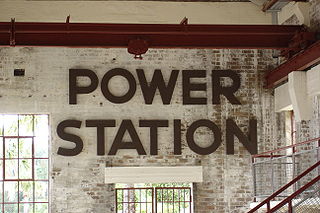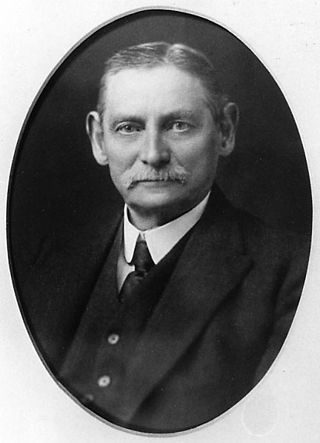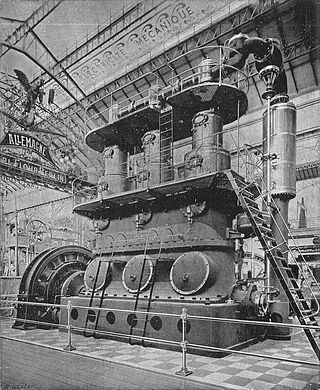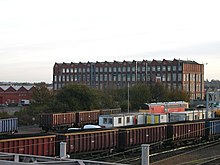
A locomotive or engine is a rail transport vehicle that provides the motive power for a train. If a locomotive is capable of carrying a payload, it is usually rather referred to as a multiple unit, motor coach, railcar or power car; the use of these self-propelled vehicles is increasingly common for passenger trains, but rare for freight trains.

George Westinghouse Jr. was an American entrepreneur and engineer based in Pennsylvania who created the railway air brake and was a pioneer of the electrical industry, receiving his first patent at the age of 19. Westinghouse saw the potential of using alternating current for electric power distribution in the early 1880s and put all his resources into developing and marketing it. This put Westinghouse's business in direct competition with Thomas Edison, who marketed direct current for electric power distribution. In 1911 Westinghouse received the American Institute of Electrical Engineers's (AIEE) Edison Medal "For meritorious achievement in connection with the development of the alternating current system". He founded the Westinghouse Electric Corporation in 1886.

The English Electric Company Limited (EE) was a British industrial manufacturer formed after the armistice ending the fighting of World War I by amalgamating five businesses which, during the war, had been making munitions, armaments and aeroplanes.

A stationary engine is an engine whose framework does not move. They are used to drive immobile equipment, such as pumps, generators, mills or factory machinery, or cable cars. The term usually refers to large immobile reciprocating engines, principally stationary steam engines and, to some extent, stationary internal combustion engines. Other large immobile power sources, such as steam turbines, gas turbines, and large electric motors, are categorized separately.
Electrification is the process of powering by electricity and, in many contexts, the introduction of such power by changing over from an earlier power source.
Metropolitan-Vickers, Metrovick, or Metrovicks, was a British heavy electrical engineering company of the early-to-mid 20th century formerly known as British Westinghouse. Highly diversified, it was particularly well known for its industrial electrical equipment such as generators, steam turbines, switchgear, transformers, electronics and railway traction equipment. Metrovick holds a place in history as the builders of the first commercial transistor computer, the Metrovick 950, and the first British axial-flow jet engine, the Metropolitan-Vickers F.2. Its factory in Trafford Park, Manchester, was for most of the 20th century one of the biggest and most important heavy engineering facilities in Britain and the world.

Ruston & Hornsby was an industrial equipment manufacturer in Lincoln, England founded in 1918. The company is best known as a manufacturer of narrow and standard gauge diesel locomotives and also of steam shovels. Other products included cars, steam locomotives and a range of internal combustion engines, and later gas turbines. It is now a subsidiary of Siemens.

The Balmain Power Station was located at Iron Cove, 4 km (2 mi) from Sydney in New South Wales, Australia. The station no longer exists and residential properties now occupy the site. This plant is often confused with the White Bay Power Station, the remains of which are still standing in Rozelle.
Dick, Kerr and Company was a locomotive and tramcar manufacturer based in Kilmarnock, Scotland and Preston, England.

James Laird Gray (1926–2010) was a Scottish engineer who helped develop several power stations in England and Scotland. An important figure in the field of steam turbine technology in the UK, he received the Thomas Hawksley Medal and the James Clayton Award from the Institute of Mechanical Engineers for his work at two nuclear power stations.

Coventry Ordnance Works was a British manufacturer of heavy guns particularly naval artillery jointly owned by Cammell Laird & Co of Sheffield and Birkenhead, Fairfield Shipbuilding and Engineering Company of Govan, Glasgow and John Brown & Company of Clydebank and Sheffield. Its core operations were from a 60-acre site in Stoney Stanton Road in the English city of Coventry, Warwickshire.

Matthew Henry Phineas Riall Sankey was an Irish engineer and captain in the Royal Engineers, known as the creator of the Sankey diagram.

Shoreham Power Station is a 420MWe combined cycle gas-fired power station in Southwick, West Sussex. It was built on the site of the Shoreham B Power Station.

The Internal Fire Museum of Power is a museum of internal combustion engines in West Wales. The museum's collection is mostly of larger stationary diesel engines, as used for generating sets and pumping stations. The museum is located at Tan-y-groes, Ceredigion, near Cardigan.

Pyrmont Power Station was an electricity generating plant located in the Sydney suburb of Pyrmont, New South Wales.

The Willans engine or central valve engine was a high-speed stationary steam engine used mainly for electricity generation around the start of the 20th century.

Peter Brotherhood (1838–1902) was an English engineer. He invented the Brotherhood engine used for torpedoes as well as many other engineering products.

Leicester power stations are a series of electricity generating stations that have provided electric power to the City of Leicester and the wider area from 1894. The first station, located within Aylestone gas works, supplied electricity for street lighting. The city's new electric tram system was supplied from 1904 by a station at Lero which operated until 1930. A large coal-fired power station was constructed at Freemans Meadow in 1922 and was operational until 1976. Finally a gas turbine power plant was commissioned in 1976.

The Nottingham Corporation Electricity Department was responsible for the production and supply of electricity in Nottingham, England, from 1894 to 1948.


















